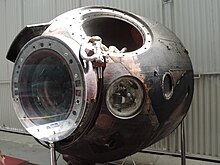Soyuz 28
| Mission dates | |||||||
|---|---|---|---|---|---|---|---|
| Mission: | Soyuz 28 | ||||||
| COSPAR-ID : | 1978-023A | ||||||
| Spacecraft: |
Soyuz 7K-T ( GRAY index 11F615A8) serial number 45 |
||||||
| Dimensions: | 6800 kg | ||||||
| Launcher: | Soyuz U (GRAY index 11A511U) | ||||||
| Call sign: | Зенит ("zenith") | ||||||
| Crew: | 2 | ||||||
| Begin: | March 2, 1978, 15:28 UTC | ||||||
| Starting place: | Baikonur 1/5 | ||||||
| Space station: | Salyut 6 | ||||||
| Coupling: | March 3, 1978, 17:09:30 UTC | ||||||
| Decoupling: | March 10, 1978, 10:23:30 UTC | ||||||
| Landing: | March 10, 1978, 13:44 UTC | ||||||
| Landing place: | 51 ° N 67 ° E 135 km north of Arkalik |
||||||
| Flight duration: | 7d 22h 17m | ||||||
| Earth orbits: | 125 | ||||||
| Rotation time : | 88.95 (91.38) min | ||||||
| Apogee : | 275.6 (364) km | ||||||
| Perigee : | 198.9 (335.8) km | ||||||
| ◄ Before / After ► | |||||||
|
|||||||
Soyuz 28 is the mission name for the flight of a Soviet Soyuz spacecraft to the Soviet space station Salyut 6, which started on March 2, 1978 . It was the third visit by a Soyuz spacecraft to this space station and the 46th flight in the Soviet Soyuz program.
crew
Main team
- Alexei Alexandrovich Gubarev (2nd space flight), commander
-
Vladimír Remek (1st space flight), flight engineer ( Czechoslovakia )

Substitute team
- Nikolai Nikolajewitsch Rukawischnikow , commandant
-
Oldřich Pelčák , board engineer ( Czechoslovakia )

Mission overview
Another mission name for the flight is Salyut 6 EP-2 ( Russian Экспедиция посещения 2 - visiting team 2).
With the visit of the Czech intercosmonaut Vladimír Remek as the first non-Soviet cosmonaut and non-US astronaut, the possibilities of the space station were expanded. On the one hand, further propaganda-effective first achievements of socialist states (first flight for the host country in each case) could be achieved, on the other hand, the scientific potential of these countries after the first unmanned satellites was also tapped for manned space flight. The rules of the Interkosmos organization were further developed. Both the course of the missions and the propaganda design (e.g. press work) were based on the experiences of the Soyuz Apollo project .
The core of the relatively uniform Interkosmos missions were therefore the original broadcasts of the start, discussions with the respective party or state leaders and greetings to the home population. In addition, observations and recordings (with the MKF-6 camera also multispectral) of the guest's home country, medical-biological examinations and experiments with products typical of the country were carried out. The guest visit was designed for about 7 days and 21.5 hours (with a tolerance of +/- one hour). The preparation of these missions did not take a lot of time, as military pilots who were mostly trained in the Soviet Union (i.e. who had language skills) could be used.
In the case of Soyuz 28, the party leaders were Leonid Brezhnev and Gustáv Husák . The national experiments dealt with material science.
The mission was successfully completed on March 10, 1978 with the landing in the Kazakh steppe. Just eight days later, the regular team Georgi Grechko and Juri Romanenko also landed . Certainly urgent for the latter, as he had contracted a tooth infection that could not be adequately treated in the ward.

The return capsule from Soyuz 28 can be seen today in the Kbely Aviation Museum in Prague.
See also
- List of Soyuz missions
- List of Salyut 6 expeditions
- List of manned missions to the Salyut 6 space station
- List of manned space flights
- List of spacemen
- Manned space travel
- Country statistics of manned spaceflight
Web links
- Soyuz 28 at spacefacts.de
- Soyuz 28 at space.kursknet.ru (English / Russian , archived 2016)
- Soyuz 28 in the Encyclopedia Astronautica (English)
- Soyuz 28 in the NSSDCA Master Catalog (English)
- Soyuz 28 at spacepatches.nl (English)
